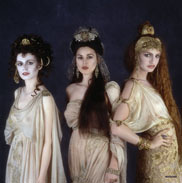| Gender
Roles |
| Gender plays a major part in any story, laying the groundwork for
the characters' actions and personalities. Creators of stories use
stereotypes of gender roles to determine how their characters will
act and interact. In a way, gender is what first connects an
audience member to a character in a story. Heterosexual women tend
to connect to female characters as fellow women who experience many
of the same challenges and excitements as they do and to men in a
more sexual way. Homosexual women tend to connect to female
characters in a more sexual way. Heterosexual and homosexual men
connect to male characters in much the same ways, respectively.
Women can also connect to male characters, and men to female, but in
very different ways. Instead of connecting with a character based
on similarities, they tend to connect in a more sexual way. |
| In the late 1800s, there was a "gendered ideology" that paired "that
which is civilized with the feminine and that which is uncivilized
with the masculine" (Wyman and Dionisopoulos 32). What this pairing
did was create an expectation for women to be more motherly,
nurturing, delicate, and civilized, and for men to be aggressive,
indulgent, destructive, and primitive. The characters in Bram
Stoker's Dracula demonstrate these characteristics. But Stoker's
story is one from the Victorian age. Have these characteristics
been maintained in popular characters today? |
| According to Wyman and Dionisopoulos, the mass media has the ability
to "define what is normal and what is deviant" but is best at
"embellishing attitudes already in place" in society (Wyman and
Dionisopoulos 35). What this means is that people see something on
television, such as depictions of gender roles, and come to
understand it as normal. But they can only see it that way because
it has already been placed in society as acceptable, or on its way
there. Take, for example, homosexuality. Before homosexuality became
more visible on television and movies, there was a social
movement in place to gain acceptance for homosexuals. The
introduction of the movement to movies and television shows proved
the placement of the movement as important in society. The
placement in movies and television shows also helped to cement the
movement in the minds of the audiences and encouraged the people to
accept homosexuality as normal. The longer that homosexuality
remains on television, the more normal it becomes to people. |
| The ability of mass media to "embellish attitudes already in place
and inspire behaviors for which the seeds have already been planted"
(Wyman and Dionisopoulos 35), means that the depictions of gender
roles in television and movies should evolve with the changing times
because popular ideals of gender roles have also changed. According
to Barbara Welter, in the Victorian Era, women were "defined by the
virtues of 'piety, purity, submissiveness, and domesticity'" (quoted
in Kitch 245). In today's world, however, women are in the
workforce, raising children on their own, and running companies.
Women in the 2000s are supposedly strong and empowered with the
ability to have sex with whomsoever they please whensoever they
please.
The purpose of this section is to explore the changes in both the
male and female gender roles that have occurred in vampire stories
from the Victorian Era to today. To provide some clarity, I have
divided the discussion between the two genders. The pages can be
viewed in any order you please without inducing confusion. |
|
|







